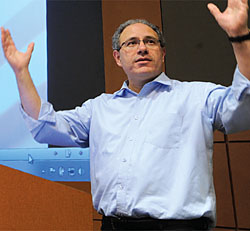
NYSUT Executive Vice President Andy Pallotta
speaks to the union's Political Action Committee
during a strategy session to map out the union's
advocacy efforts that include seeking reforms to
the tax cap and more funding for education and
health care. Photo by El-Wise Noisette.
Rob Pearl's family, like many across New York state, is paying a dear price thanks to the state's property tax cap.
When his son enters third grade, he will be bused across town rather than go to the school next door because the district saved money by reorganizing elementary grades. The few extra-curricular activities for the primary grades are now so overcrowded just one teacher tends to 100 students.
His daughters in the secondary grades in the Comsewogue school district on Long Island no longer can work on a school newspaper or be in a language club. Their choices in art, music and sports are far fewer now that programs were cut.
The budget for classroom supplies, textbooks and technology for Pearl's middle school special education students has been slashed. As a teacher, the possibility he will be able to attend a professional development course is slim at best.
Pearl, who also is an officer in the Port Jefferson Station Teachers Association, blames the tax cap.
"I voted yes on a school budget that would support the families and children in this community so they would have continued opportunity to acquire a competitive education," he said.
Yet, even though a majority — 59 percent — of voters supported a school budget that called for a 4.5 percent increase, it failed.
The property tax cap requires the approval of a supermajority of voters — 60 percent — to exceed the cap, which in Comsewogue's case was 2.6 percent.
School budgets in 18 other districts went down in similar fashion.
A big stick in the tax cap law for districts that try to exceed their cap twice in a row? If they fail to get the necessary supermajority, the levy cannot increase one cent beyond the previous year. With that threat in mind, Comsewogue schools put forth a second budget proposal with a 2.6 percent increase that passed with a 78 percent yes vote.
New York state's property tax cap was put in place two years ago to limit a local government's overall growth in the property tax levy to 2 percent or the rate of inflation, whichever is less.
Remember, it's the tax levy that is capped, so based on the levy and a few limited exceptions, such as one-time needs for large legal settlements and pension growth, the budget increase can be less or more than 2 percent. (Even worse, considering the devastation Superstorm Sandy caused in areas downstate, the tax cap doesn't allow districts to accommodate local needs based on weather-related expenses.)
NYSUT members continue to call on lawmakers to reform the devastating tax cap and will press their case during advocacy days and visits to lawmakers' district officers.
The statewide union has been preparing a lawsuit on the issue that will be filed relatively soon, said NYSUT President Dick Iannuzzi. "At the end of the day, it's about equity and fairness," he said.
A preliminary analysis by NYSUT shows that voters in districts with more wealth overrode the cap when given that option, while voters in low-wealth districts did not, indicating the law puts an unfair burden on districts that have fewer resources.
"Schools have drawn down their reserves," said NYSUT Executive Vice President Andy Pallota. "Some districts are on the brink of insolvency. Employees have reopened contracts to provide savings. Thousands of educators have been laid off."
For Pearl, those costs are bad enough, but there's one more. "When a minority of 40 percent decides what happens in a community, then we no longer exist as a democracy." Pearl said.